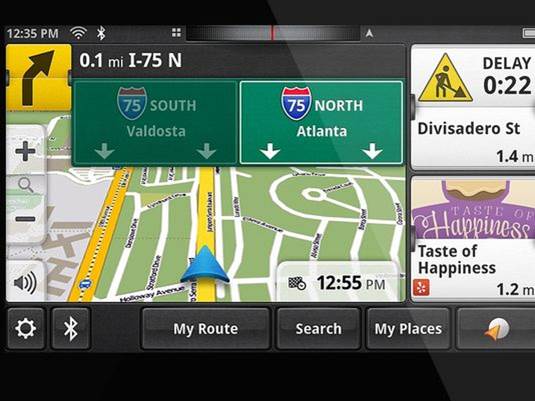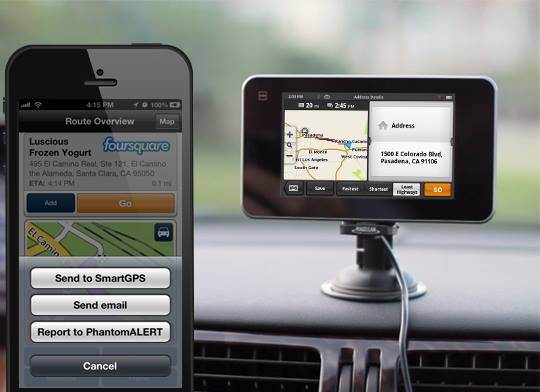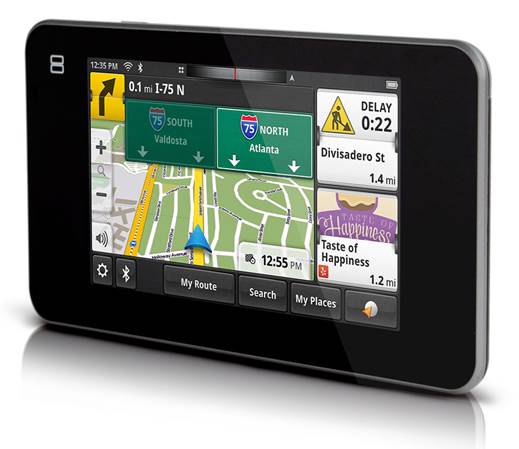Routing and navigating
Despite the bad UI, I am still using
SmartGPS to look for directions of many national parks, hotels or restaurants.
As in a navigating device, it performs really well. You need to stretch your
arm and push the “zoom out” button on the screen to get a better view about
your destination (there is no voice command here), but I have to admit that the
included speed limit warning is surely a gift from god. It is so easy to ignore
any speed warning signs when you are entering a new town, and so the “beep” sound from
the device keep me driving safely.
Another impressive feature is that its
ability to search for the desire destinations by using the included mobile
application, then sharing with the SmartGPS. This allows the drivers to type in
their destinations on their phones then transfer the data to SmartGPS. I have
to say that this feature is working so well whereas the search and discovery
methods just feel entirely antiquated. The POI database is as robust as you'll
find, but it's just not robust (nor personal) enough. Allow me to explain.

Routing
and navigating interface
SmartGPS allows users to search Foursquare
and Yelp destinations, as well as those pre-loaded onto the device. But if you
put in half of a hotel's name that is some 380 miles away, you will probably
get nothing in return. Let’s make a quick comparison with Google Maps on iPhone
– while I am in South California, I start typing in “Hampton inn Montrose co.”
I get to "ham" before Google senses that I probably want to look for
a hotel I tagged last week while using my laptop to scope things out ahead of
time. And there it is - the second option from the drop-down menu. Bang-done.
You definitely can save that hotel into the Micloud’s list and let the SmartGPS
redoes the same process, but that is a service that I have never tried. Also,
by looking at the number of user using Google Maps, I am pretty sure that many
people reading this article would have the same opinion as me.
The Challenge
I really appreciate the fact that Magallen
is trying to hawk a $250 GPS extension to a smartphone app, when the reality is
that the phone itself is an infinitely superior navigator. My setup involves an
iPhone 4S, an $11 Arkon
universal vent mount and a $12
cigarette adapter for USB charging. The Google Maps app is free, and
if you're in Magellan's target market, you probably already own a smartphone.
Considering that as a required cost, you can have a far more powerful, far more
personal navigation experience for less than $25 in accessories - recall that
those help you to travel more easily than the SmartGPS, and won't block your
view.

The
Google Maps app is free, and if you're in Magellan's target market, you
probably already own a smartphone.
On top of that, using smartphone as a
navigator would give you a better experience. Far more than that, nowadays,
many car manufacturers also provide you with the Audio Bluetooth support,
allowing you to low down the music volume while making any commands; and this
means that you're already set up for hands-free calling should someone ring
you. The only advantage that the PNDs still have today is that you can look up
for your destinations independently of the appearance of internet connection,
or finding POI in a place where there's no cellular service. Increasingly,
that's not a big deal anymore, but even if you're concerned about such a thing
-- how can you beat a $50 Garmin
app that enables you to download offline maps of the entire
United States?
Conclusion
The $250 SmartGPS wasn't built for bad
reason, but it's simply not worth the price. The massive size of it obstructs
the driver's view, and although it is able to display a lot of information at
once, attempting to analyze all of that while driving just feels not a smart idea.
Beyond all of that, the graphical elements are too old, and the interplay
between the device itself and the accompanying app is not stable.

The
Magellan SmartGPS
To maximize its performance, you need to
pair it with a smartphone. And if you already own a smartphone, you are
provided with the best navigator on the market. Using your phone along with the
Arkon stand and a simple USB charger mentioned above, there is no reason to
look elsewhere.
Info
·
Price: $250
Advantage
·
Built-in Foursquare and Yelp
Disadvantages
·
Massive size
·
Complicated user interface
·
Not useful
Verdict
·
SmartGPS 250 was not built for a bad reason, but
it is just simply not worth the money.
Specification
|
Device
·
Dimensions (Metric) 160 mm x 90 mm x 14 mm
·
Weight (Metric): 355 g
·
Battery Type: 1100 mAh Li-ion rechargeable
·
Battery Life: 30 minutes
·
Microphone: Yes
·
Speaker: Yes
·
CPU: Texas Instruments Cortex A8
·
Expandable Memory: microSD
·
Temperature Range (F): 14F to 158F
·
Temperature Range (C): -10C to 70C
·
Audio/Video Input: Yes
·
SD Slot: Yes
·
Package Contents: SmartGPS Unit with Battery, Windshield
Mount, Vehicle Power Adapter, Micro USB Cord, USB AC Adapter, Quick Start
Guide, SmartGPS Apps Download Card
Screen
·
Display Resolution, WxH 800 x 480 WVGA
·
Screen Size: 5.0"
·
Display Type: Capacitive
·
Touch Screen: Yes
GPS & Sensors
·
GPS Accuracy: 3-5 Meters
·
High-Sensitivity GPS: Yes
·
Antenna Type: Multidirectional Patch
Mapping & Navigation
·
Preloaded Maps: US, Canada, Puerto Rico
·
Points of Interest: 7M
·
Turn-by-Turn Routing: Yes
·
AAA TourBook: Yes
·
Lifetime Traffic Alerts: Yes
·
Highway Lane Assist: Yes
·
Map Updates: Lifetime
·
Multi-Destination Routing: Yes
·
OneTouch Favorites Menu: Yes
·
Speed Limits: Yes
·
Spoken Street Names: Yes
·
Branded POIs: Yes
·
POIs Along Route: Yes
·
Smart City Search: Yes
·
Smart Detour: Yes
·
Landmark Guidance: Yes
·
Bluetooth Safe Texting: Yes
·
Junction view: Yes
·
Best Parking: Yes
·
Traffic Camera Alerts by PhantomALERT: Yes
·
Yelp Integration: Yes
·
Foursquare Integration: Yes
·
Gas Prices: Yes
·
Weather: Yes
·
User Generated Content
·
Waypoints: 20
Interface & Communications
·
USB Port USB: 2.0 (micro)
·
PC Compatible: Yes
·
MAC Compatible: Yes
·
Bluetooth: Yes
·
Wi-Fi: Yes
·
Cellular: Yes
|